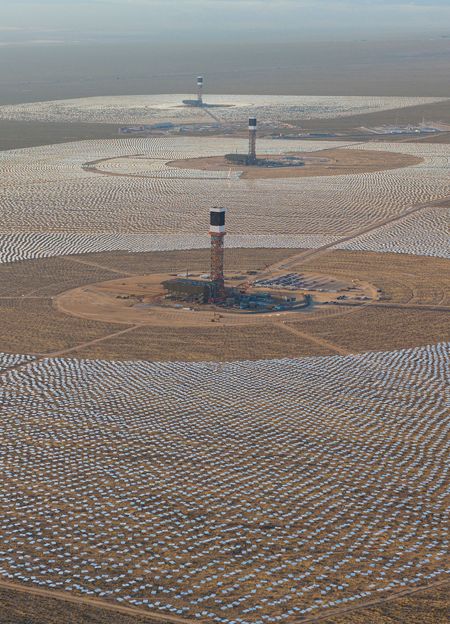
Ivanpah Solar Electric Generating System in California’s Mojave Desert / Utility Dive
“In a fractured, perplexing world, it’s easy to be pessimistic. But if we pull back, we can see there are deeper, more coherent forces at work. If we looked at today from 500 years in the future, we would see we are at an extraordinary moment in history. What’s really happening is the reinvention of America,” argued Peter Leyden, author of The Long Boom, and What’s Next?, at the opening plenary of the American Planning Association (APA) annual meeting in New York City. He added that: “no country can go through this kind of transition without experiencing major political change. There is intense polarization and paralysis at the beginning of every transition. President Trump is a classic reaction to change. Change is hard and scary; it’s very appealing to go back. But what happens next is we will get through the transition.”
The United States has experienced four eras of deep structural change, each taking a number of years to take root. “We are in the fifth transition now.” From 1800-1850, the country saw a transformation to mechanized agriculture; from 1850-1900, we shifted to the early industrial era; from 1900-1950, America moved to the urban industrial era; and from 1950-2000, we saw the rise of the post-war suburban era. At the beginning of each of these major transitions, there was political paralysis and efforts to stop change, but deeper forces pushed us towards a new economy and society.
Beginning in 2000, Leyden argued, the U.S. began the latest massive transformation, characterized by “the digitization of everything.” Connecting all computers in the world was a “world historical event.” With technology organized on a global scale, “we also started the globalization of everything.”
The “unprecedented challenges” facing the world today — climate change, mass migration, rising inequality, education system failures, and pandemics — are “the classic symptoms of systemic change.”
Leyden is optimistic we can make our way through these challenges, just as we have in the past. “I believe this story has a happy ending.”
Leyden outlined some of the deeper forces at work today:
Digitalization: Today, computers are 25 times more powerful than they were 40 years ago. In 1975, 200 mega flops cost $31 million; today, 300 giga flops costs $649, the price of a new iphone. In 1981, one gigabyte of storage cost $700,000; today, the same amount costs 4 cents. From before the birth of Christ to 2003, humans created around 5 exabytes of data; today, we create the same amount of data every two days. Before 1990, 6 percent of data was digitized; now, “data is all digital.”
In 2000, just 5 percent of the world was online; today, 40 percent are, and soon everyone will be. Already, 75 percent of the planet has a cell phone. “Soon everyone will have 4G and the entire world will be able to send videos.” And there are “more technological wonders to come, with artificial intelligence and robotics.”
But the downside is an estimated 47 percent of all jobs in the U.S. will be “vulnerable to automation in the next 20 years. Routine, non-creative jobs will go away.” Still, Leyden believes new types of jobs will take the place of old ones, just as has occurred in past transitions. The total number of jobs has always increased.
Globalization: The world economy and financial markets are increasingly inter-connected. People are more connected than ever, too. Some $7.4 trillion, or 10 percent of global GDP, is associated with travel and tourism, more than the share of the global economy associated with oil, which is around $5 trillion. In addition, the world’s most valuable companies today, including Apple and Facebook, are all about facilitating global communications. Amid worries the U.S. is falling behind on the innovation front, Leyden reminded us U.S. firms dominate the list of most valuable companies.
“Integrated markets and new technologies are driving global economic growth.” However, while productivity rates have increased, family incomes in the U.S. have stagnated. This is an issue that needs to be addressed.
Demographic shifts: In the U.S., 10,000 baby boomers retire every day. At the same time, millennials have now surpassed the boomers as the largest generation, and they make up the majority of the workforce today.
Like all up-and-coming generations, “millennials will reinvent the world. They are tech-savvy, civic-minded, collaborative, diverse, global, and green.” They are also moving into cities in great number and driving less. Today, 63 percent of the American population lives in cities; that number will go even higher. Millennials are also more diverse, and their children will be, too. “By 2050, whites will be a minority, just like they are in California today.”
Environmental change: There are now 399 parts per million (ppm) of carbon dioxide in our atmosphere. Sixteen of the hottest days on record happened since 2001. But there are glimpses of a positive, sustainable future.
“Solar and wind will soon be cheaper than oil, coal, and gas.” And while we are well into the information technology revolution, the energy technology revolution is just in its early stages. Once inter-state energy grids are rebuilt to more-easily enable the flow of solar and wind power across state lines, we’ll see renewables take over.
Leyden likened the national political dysfunction happening today to what happened in California in the 90s and 00s. As whites became a minority and the economy shifted, there was extended deadlock in Sacramento. But eventually a new consensus was reached, and California is once again leading the way forward, with the fastest and most sustainable economy in the country.
The last time the U.S. went through a major national transition right after World War II, just 5 percent of the population had a college degree. Today, more than 30 percent do. With all those extra skills, Leyden is confident our current transition will be smoother and faster. It’s the next one in 2050 or sooner that he’s now focused on — will it be nano-technology-driven?
